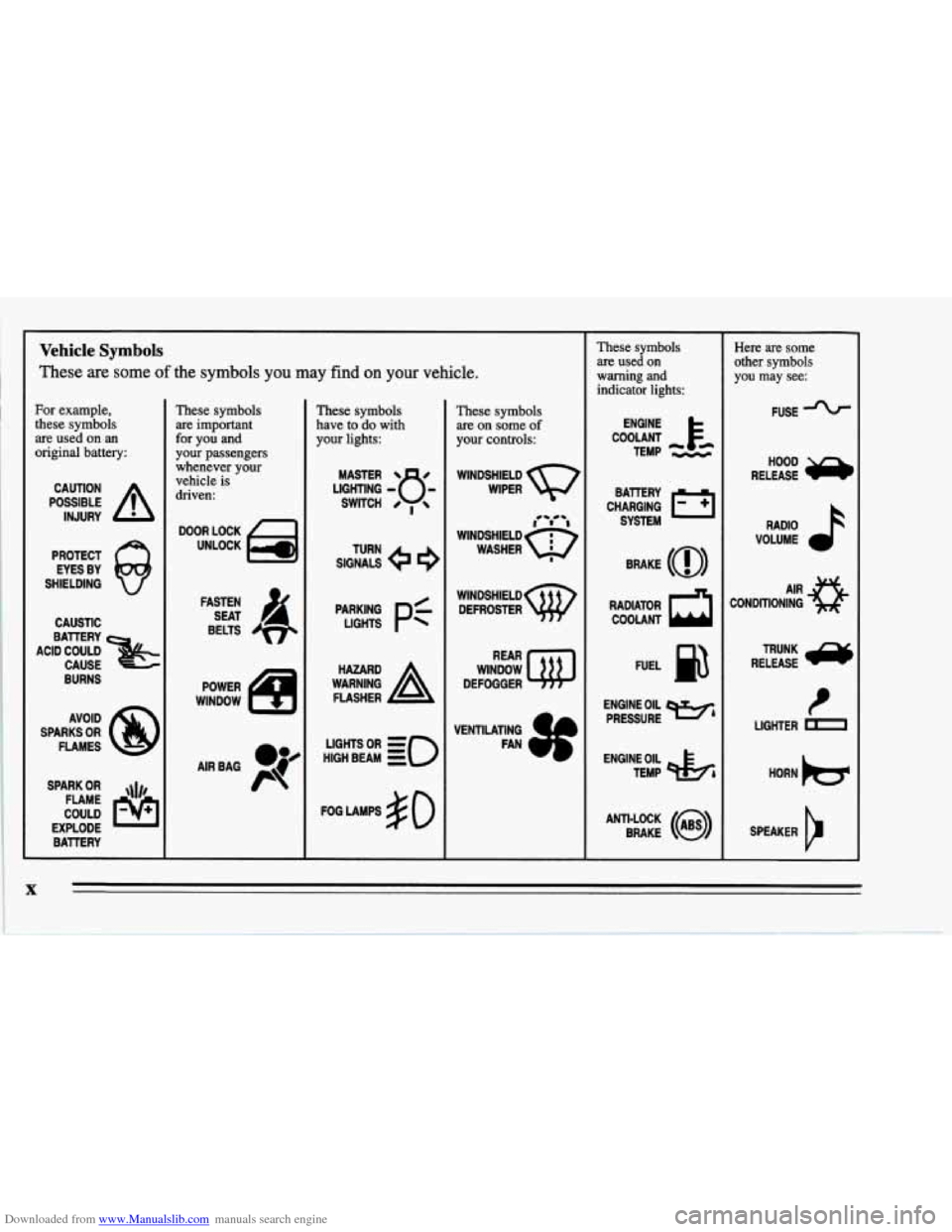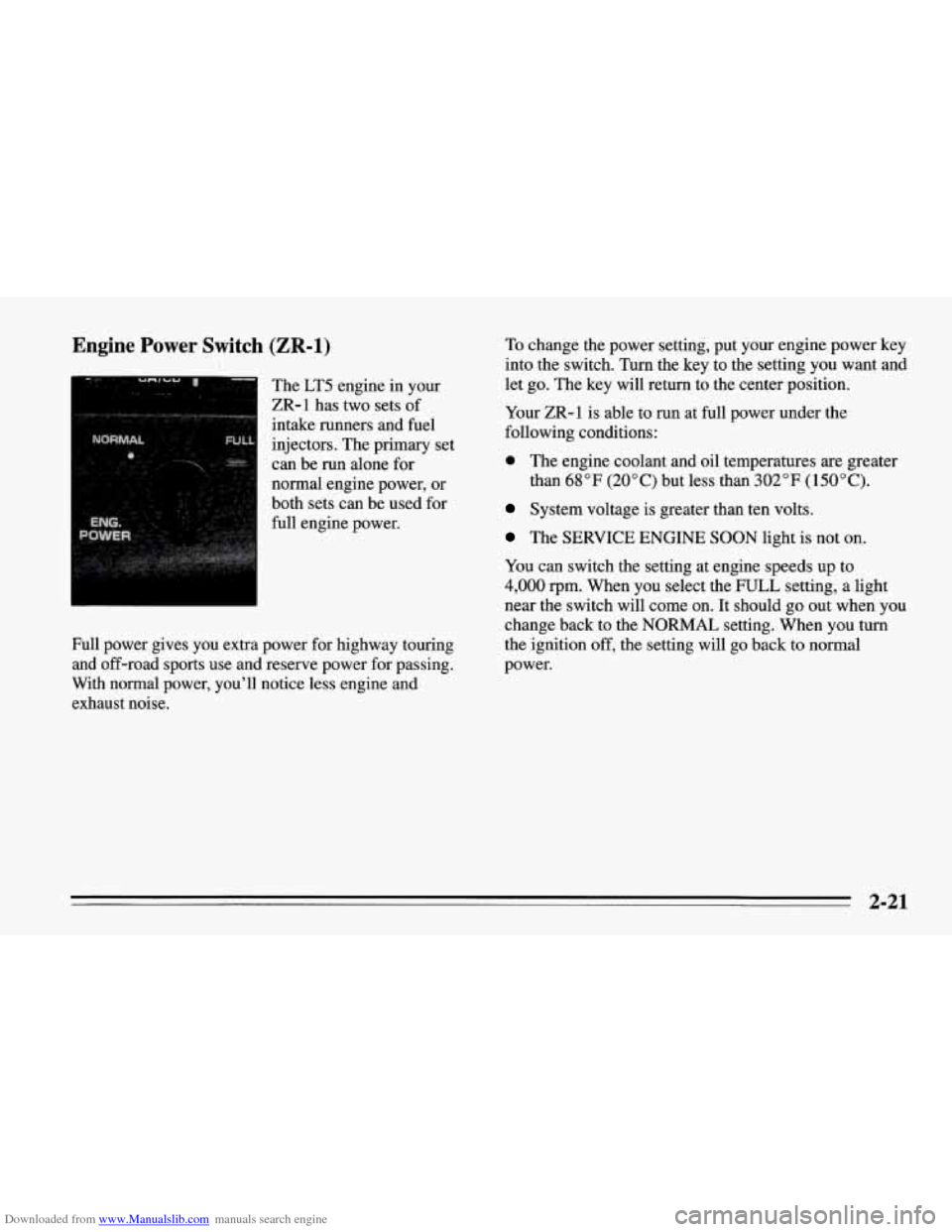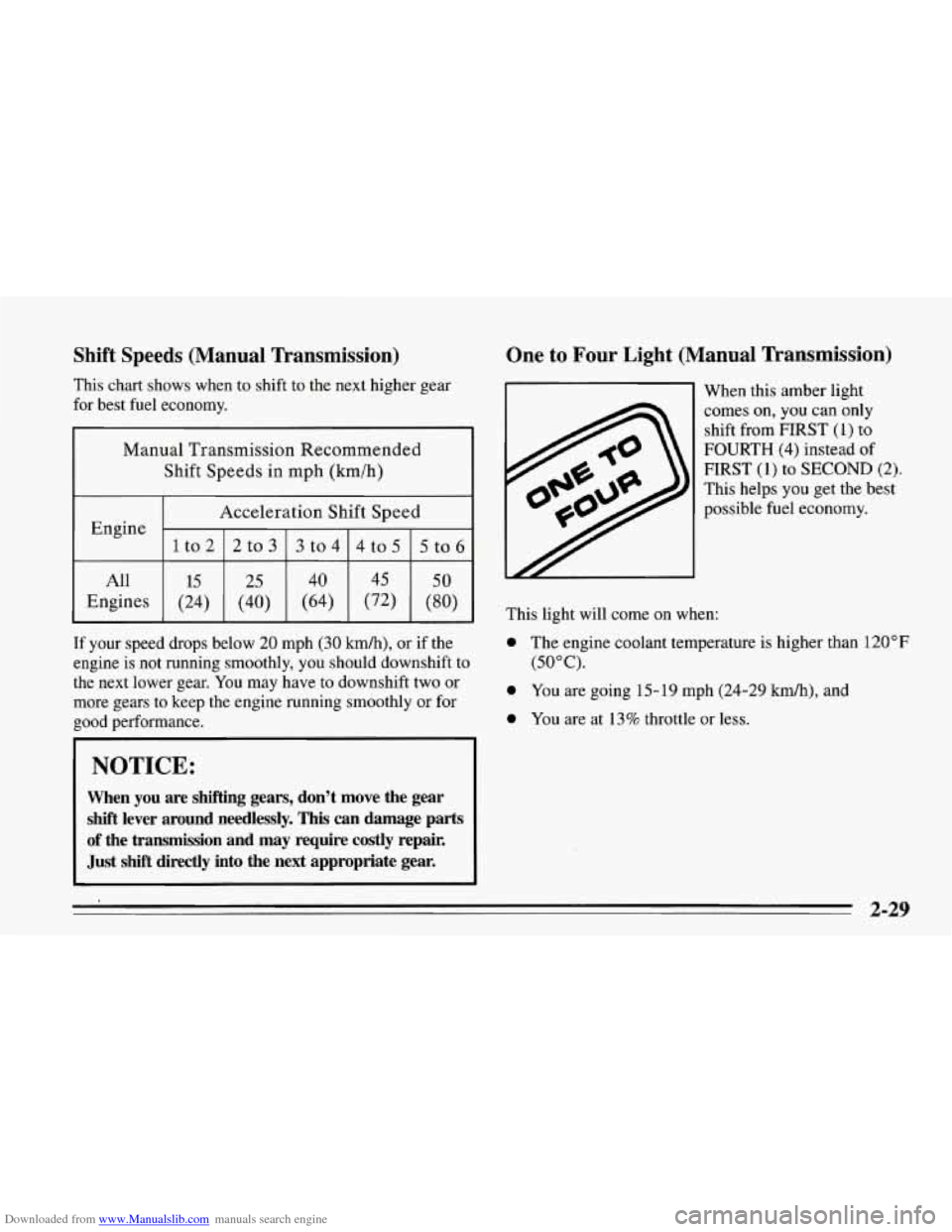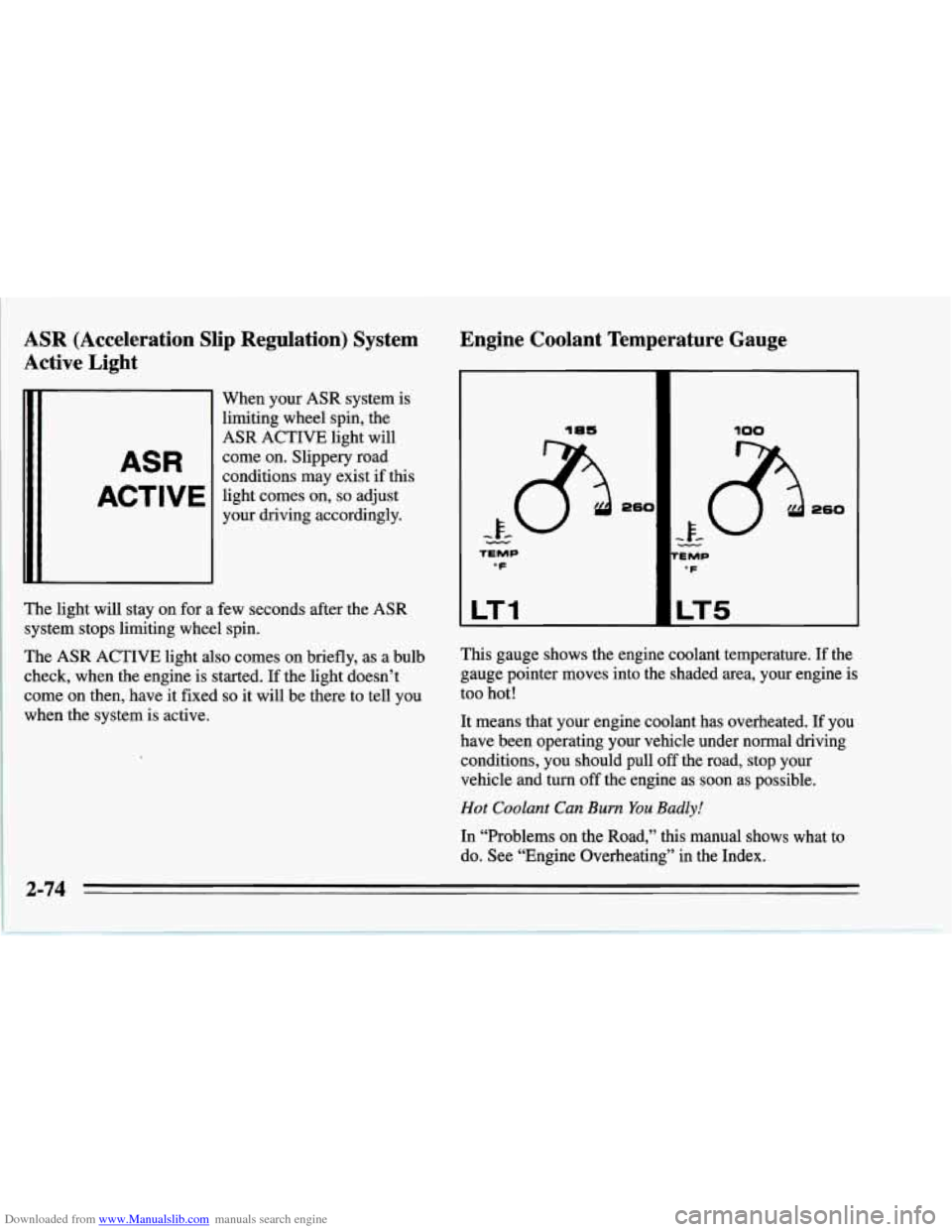Page 11 of 386

Downloaded from www.Manualslib.com manuals search engine Vehicle Symbols
These are some of the symbols you may find on your vehicle.
For example,
these symbols
are used on an
original battery:
POSSIBLE A
CAUTION
INJURY
PROTECT EYES BY
SHIELDING
Q
CAUSTIC
ACID COULD
&
BATTERY CAUSE
AVOID
SPARKS
OR
FLAMES
SPARK
OR ,\I/,
COULD FLAME
EXPLODE BATTERY
These symbols
are important
for you and
your passengers whenever your
vehicle
is
driven:
DOOR LOCK
UNLOCK
FASTEN SEAT
4
BELTS
POWER
WINDOW
AIRBAG P
These symbols
have to do with
your lights:
SIGNALS e e
TURN
p:
HIGH BEAM OR = so
FOG LAMPS # 0
These symbols
are on some
of
your controls:
WINDSHIELD
WIPER
WINDSHIELD DEFROSTER
WINDOW
DEFOGGER
VENTILATING FAN
These symbols
are used
on
warning and
indicator lights:
ENGINE
TEMP
--
CHARGING I-1
BATTERY SYSTEM
RADIATOR
COOLANT a
FUEL
ENGINE OIL PRESSURE
Wb
TEMP OtL ctlb
ANTI-LOCK (@)
BRAKE
~~ ~~~ ~ ~~
Here are some
other symbols
you may see:
FUSE -%-
RELEASE
RADIO
VOLUME
CONDITIONING
AIR 43
t
LIGHTER D
HORN )cr
SPEAKER
b
X
Page 64 of 386

Downloaded from www.Manualslib.com manuals search engine Engine Power Switch (ZR-1)
The LT5 engine in your
ZR-1 has two sets of
intake runners and fuel
injectors. The primary set
can be run alone for
normal engine power, or
both sets can be used for
full engine power.
Full power gives you extra power for highway touring
and off-road sports use and reserve power for passing.
With normal power, you’ll notice less engine and
exhaust noise. To
change the power setting, put your engine power key
into the switch. Turn the key to the setting
you want and
let go. The key will return to the center position.
Your ZR-1 is able to run at full power under the
following conditions:
0 The engine coolant and oil temperatures are greater
than
68°F (20°C) but less than 302°F (150°C).
System voltage is greater than ten volts.
The SERVICE ENGINE SOON light is not on.
You can switch the setting at engine speeds up to
4,000 rpm. When you select the FULL setting, a light
near the switch will come on.
It should go out when you
change back to the NORMAL setting. When you turn
the ignition off, the setting will go back to normal
power.
2-21
Page 66 of 386
Downloaded from www.Manualslib.com manuals search engine Engine Coolant Heater (Canada Only)
In very cold weather, 0°F (- 18 "C) or colder, the engine
coolant heater can help. You'll get easier starting and
better fuel economy during engine warm-up. Usually,
the coolant heater should be plugged
in a minimum of
four hours prior to starting your vehicle.
To use the coolant heater:
1. Turn off the engine.
2. Open the hood and unwrap the electrical cord.
3. Plug it into a normal, grounded 1 10-volt outlet.
8 2-23
Page 67 of 386
Downloaded from www.Manualslib.com manuals search engine I NOTICE:
After you’ve used the coolant heater, be sure to store the cord
as it was before to keep it away
from moving engine parts. If you don’t, it could
be damaged.
How long should you keep the coolant heater plugged
in? The answer depends on the weather, the kind
of oil
you have, and some other things. Instead
of trying to list
everything here, we ask that you contact your Chevrolet
dealer in the area where you’ll be parking your vehicle.
The dealer can give you the best advice for that
particular area.
Automatic Transmission
There are several different positions for your shift lever.
PARK (P): This locks your rear wheels. It’s the best
position
to use when you start your engine because your
vehicle can’t move easily.
2-24
Page 72 of 386

Downloaded from www.Manualslib.com manuals search engine Shift Speeds (Manual Transmission)
This chart shows when to shift to the next higher gear
for best fuel economy.
Manual Transmission Recommended
Shift Speeds in mph
(krn/h)
Acceleration Shift Speed
1to2
5to6 4to5
3to4
2to3
Engine
All
(80) (72)
(64)
(40)
(24) Engines
50 45 40
25 15
If your speed drops below 20 mph (30 kmk), or if the
engine is not running smoothly, you should downshift to
the next lower gear. You may have to downshift two or
more gears to keep the engine running smoothly or for
good performance.
NOTICE:
When you are shifting gears, don’t move the gear
shift lever around needlessly. This can damage parts
of the transmission and may require costly repair.
Just
shift directly into the next appropriate gear.
One to Four Light (Manual Transmission)
This light will come on when: When
this amber light
comes
on, you can only
shift from
FIRST (1) to
FOURTH
(4) instead of
FIRST (1) to SECOND (2).
This helps you get the best
possible fuel economy.
0 The engine coolant temperature is higher than 120°F
(50°C).
0 You are going 15-19 mph (24-29 km/h), and
0 You are at 13% throttle or less.
2-29
Page 117 of 386

Downloaded from www.Manualslib.com manuals search engine ASR (Acceleration Slip Regulation) System
Active Light
ASR
ACTIVE
When your ASR system is
limiting wheel spin, the
ASR ACTIVE light will
come on. Slippery road
conditions may exist
if this
light comes on,
so adjust
your driving accordingly.
The light will stay on for a few seconds after the ASR
system stops limiting wheel spin.
The ASR ACTIVE light also comes on briefly, as a bulb
check, when the engine is started. If the light doesn’t
come on then, have it fixed
so it will be there to tell you
when the system is active.
Engine Coolant Temperature Gauge
18s
TEMP
“F
LT1
100
uv
’E MP
‘F
LT5
This gauge shows the engine coolant temperature. If the
gauge pointer moves into the shaded area, your engine is
too hot!
It means that your engine coolant has overheated. If you
have been operating your vehicle under normal driving
conditions, you should pull
off the road, stop your
vehicle and turn
off the engine as soon as possible.
Hot Coolant Can Bum You Badly!
In “Problems on the Road,” this manual shows what to
do. See “Engine Overheating” in the Index.
2-74
Page 118 of 386
Downloaded from www.Manualslib.com manuals search engine For numeric gauge measurements, press the GAUGES
button on the Trip Monitor until COOL appears. The
number that appears next to the fuel gauge is the coolant
temperature. If
LO appears, the temperature is below
32°F (OOC).
,ow Coolant
1
This red light comes on
when the coolant in the
system is
low. You may
LOW
need to add coolant. See
“Engine Overheating” in the
COOLANT Index-
NOTICE:
Driving with the LOW COOLANT light on could
cause your Corvette
to overheat. See “Engine
Overheating” in the Index. Your Corvette could
be damaged, and it wouldn’t be covered by your warranty.
2-75
Page 124 of 386
Downloaded from www.Manualslib.com manuals search engine NOTICE:
Damage to your engine from neglected oil
problems can be costly and
is not covered by your
warranty.
Engine Oil Temperature Gauge
LT1 LT5
This gauge shows your engine oil temperature. Oil
temperature may vary with the type
of driving you do
and weather conditions. If your gauge pointer moves
close to or into the shaded area and stays there, your oil
temperature is too high. Check the engine coolant
temperature and engine oil level. If your engine is too
hot, see “Engine Overheating” in the Index. Your
vehicle may need service; see your dealer.
2-81